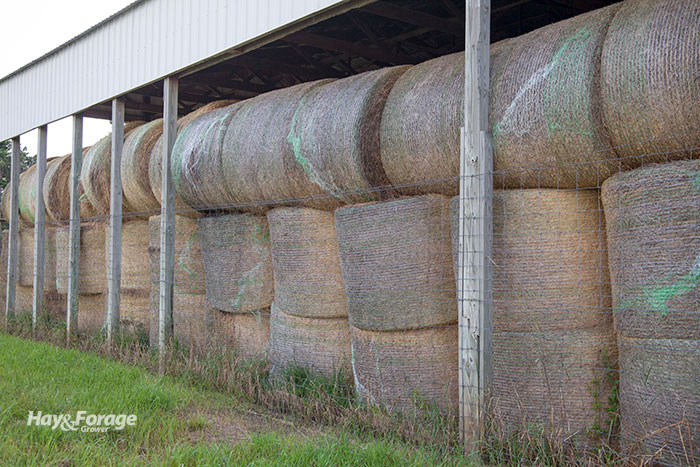
Uncovered hay that is stored outside will lose both dry matter and nutrients.
How much do these losses amount to?
Research conducted by the University of Georgia (UGA) shows that up to 60% of hay is lost when it is uncovered and stored outside. One solution, of course, is to build a hay barn and preserve both the quantity and quality of the harvested crop.
Choosing a location and building a hay barn involves several important considerations, according to Savannah Tanner, a UGA extension agent based in Emanuel County.
Drainage
“One of the biggest quality killers in hay is moisture and water,” Tanner notes. “Choosing a location in a low area can result in damage to your barn, hay loss, and expensive drainage work.”
Tanner suggests building your barn with a flooring system 6 to 8 inches above ground level. It needs to be built with a 2% slope away from the walls. Gutters and ditches will help to remove additional water away from the area. Also ensure that you have a well-drained area to load and unload the hay to keep vehicles and equipment from creating mud and ruts.
Make your barn accessible
Tanner recommends building your barn near a road with an adequate amount of space for loading and unloading hay. Plan to have an area of at least 75 by 125 feet to allow for enough space. If the barn is located on the same farm as the livestock, choose a spot that is centralized to reduce hauling and labor costs. However, Tanner notes that one central location will result in a total loss if a barn fire occurs.
Consider expansion
“Planning for expansion is often a compromise between safety and practicality,” Tanner asserts. “Allowing adequate space for future expansion by way of a separate barn could reduce the chance of fire spread from one barn to the next.”
Of course, building a separate barn rather than simply adding on to the original will be more costly and requires more space.
Air movement
Proper ventilation is key to reducing moisture and favoring air exchange. Tanner notes that the ideal building has sidewalls that are perpendicular to the primary wind direction. Include eave openings and capped ridge vents for enclosed barns. Fire risk is greatly reduced with proper air flow.
“While a hay barn can be costly to build, storing hay under a well-planned barn can result in up to $4,264 in net annual savings, according to research conducted by the UGA Extension Agricultural Economics Team,” Tanner shares.
The payback from storing hay in a barn comes in the form of more usable yield per acre and improved livestock performance as a result of higher forage quality.

Michaela King served as the 2019 Hay & Forage Grower summer editorial intern. She currently attends the University of Minnesota-Twin Cities and is majoring in professional journalism and photography. King grew up on a beef farm in Big Bend, Wis., where her 4-H experiences included showing both beef and dairy cattle.

